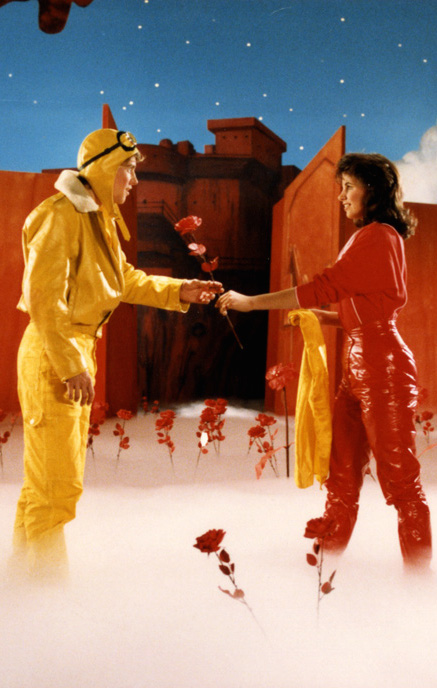Sunday, August 24, 1986.
WHEN THEY DRAW UP THE official Expo 86 heroes list, the name Bob Rogers deserves a prominent place. The Burbank-based showman can take pride in having produced two of the fair’s most original, professional and popular attractions.
For the Canadian Pacific Pavilion, he co-wrote, produced and directed the thoroughly delightful Rainbow War. An Oscar contender (in the short film category) before the fair opened, the 20-minute, 70mm picture is a lively live-action cartoon with a timely moral message.
Filmed at Vancouver's Panorama Studios, the high-energy fantasy relates the story of three celestial kingdoms. As written by Rogers, Marc Nowadnick, Alan Munro and Andy Gaskill, each kingdom has its own special character, preferred colour and distinctive musical theme (composed by David Spear, and performed by London’s Royal Philharmonic).
Each holds itself aloof from the others until the day a bright young man (Gary Carre) from the land of the tyrannical Yellow Queen (Gillian Barber) takes flight aboard a jet-propelled hula hoop.
After buzzing the Blue King (Simon Webb) and his realm, the lad crash lands in the garden of the Red Kingdom’s princess (Saffron Henderson).
Despite their tender feelings for one another, their nations are soon at war. The Blue and Yellow Monarchs invade the Red Kingdom, each determined to colour it to match his or her own world.
The battle is quickly joined, and rivers of paint are spilled in the comic combat.
At the movie's heart is a plea for universal tolerance, expressed in the best tradition of entertainment cinema. Making its point with wit, imagination and style, Rainbow War has already become an Expo classic.
The same can be said of Spirit Lodge, a very different Rogers production designed for the General Motors Pavilion. For this attraction, audiences are relatively small. The feeling is intimate and magical.
Fairgoers, in groups of 150 per show, assemble in a theatre space designed to look like a Haida longhouse. Beneath the smoke hole, in the glow of the fire pit, an old man remembers the days of his youth (a live actor lip-synching to the recorded voice of Len George).
As he speaks, he gestures and, because he is a Kwakiutl shaman, his gestures call forth images within the rising smoke. It is these images that visitors remember, because they seem to form by magic in thin air.
Much has been made of the “how” of Spirit Lodge’s Holovision process. More should be made of its “why.”
Credit is due Rogers, the show’s director Andy Gaskill and G.M. for setting aside eight minutes during Expo to ask the question “are these machines making us more like humans? Or more like machines?”
Created by Rogers with the cooperation of the native peoples of B.C., the shaman’s enchanting monologue urges us to pause and think. And so we should.
The above is a restored version of a Province review by Michael Walsh originally published in 1986. For additional information on this archived material, please visit my FAQ.
Afterword: I was among those who made much of the “how” of Spirit Lodge. Its magic was based on some traditional stage magician trickery, updated for the 1980s, techniques I discussed in my earlier Reeling Back report on the Holovision process.
Although Rainbow War did not win the 1985 Academy Award for best live-action short film (the Oscar went to Molly’s Pilgrim, the story of a Jewish immigrant girl who shows her elementary school classmates the true meaning of Thanksgiving), it won the hearts of fairgoers. At the time, I was particularly impressed by the fact that a Californian “experience designer” had taken an interest in, and the time to acquaint himself with, B.C. in the year prior to the Vancouver world’s fair. His corporate clients were a Calgary-based holding company (CP Ltd.), and a multinational headquartered in Detroit (GM Co.), so he could easily have produced his shows out of Los Angeles.
Instead, Rogers got to know our neighbourhood and its people. His research for Spirit Lodge took him as far afield as Alert Bay on Northern Vancouver Island, where he consulted with Nimpkish Band elders and recorded traditional Kwakiutl singers in the U’mista Culture Centre. Rainbow War was filmed on a local movie studio’s sound stages, and featured a cast drawn from the Vancouver talent pool. Theatre Sports — today known as Vancouver TheatreSports — gets a “special thanks” in the film’s credits. Realizing that it had a winner, CP put considerable effort into promoting its pavilion. Among the items of Expo memorabilia that I treasure most is my Rainbow War commemorative tie, a tastefully bit of haberdashery that I am wearing today as I type these afterwords. In 2011, fans of director Bob Rogers’s creation launched a fan website to celebrate its 25th anniversary. Included is a Where Are They Now? page tracing the subsequent career of Rainbow War’s cast and crew.
See also: The eight articles included in this, the fourth of four Expo 86 special reports, explore the pavilions of:
|
31: Expo 86 CP/GM (Bob Rogers) 32: Expo 86 Telecom Canada 33: Expo 86 Air Canada/CNR 34: Expo 86 Islam/Christianity |
